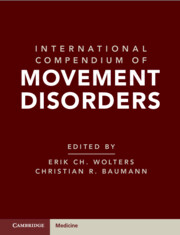Book contents
- International Compendium of Movement Disorders
- International Compendium of Movement Disorders
- Copyright page
- Contents
- Contributors
- International Compendium of Movement Disorders
- Hypo- and Hyperkinetic, Dyscoordinative and Otherwise Inappropriate Motor and Behavioral Movement Disorders
- Section 1: Basic Introduction
- Chapter 1 Behavior
- Chapter 2 The Basal Ganglia
- Chapter 3 The Role of the Cerebellum
- Chapter 4 Neuropathological Overview of Neurodegenerative Disorders
- Chapter 5 Genetic Models of Movement Disorders
- Chapter 6 Mitochondrial Movement Disorders
- Chapter 7 Metabolic Movement Disorders
- Chapter 8 Autoimmune Movement Disorders
- Chapter 9 Pediatric Movement Disorders
- Chapter 10 Neuro-Ophthalmology in Movement Disorders
- Chapter 11 Parkinson’s Disease
- Section 2: Hypokinetic Movement Disorders
- Section 3: Hyperkinetic Movement Disorders
- Section 4: Dyscoordinative and Otherwise Inappropriate Motor Behaviors
- Section 5: Objectifying Movement Disorders
- Movement Disorders in Vivo: Video Fragments
- Acronyms and Abbreviations
- Index
- References
Chapter 5 - Genetic Models of Movement Disorders
from Section 1: - Basic Introduction
Published online by Cambridge University Press: 07 January 2025
- International Compendium of Movement Disorders
- International Compendium of Movement Disorders
- Copyright page
- Contents
- Contributors
- International Compendium of Movement Disorders
- Hypo- and Hyperkinetic, Dyscoordinative and Otherwise Inappropriate Motor and Behavioral Movement Disorders
- Section 1: Basic Introduction
- Chapter 1 Behavior
- Chapter 2 The Basal Ganglia
- Chapter 3 The Role of the Cerebellum
- Chapter 4 Neuropathological Overview of Neurodegenerative Disorders
- Chapter 5 Genetic Models of Movement Disorders
- Chapter 6 Mitochondrial Movement Disorders
- Chapter 7 Metabolic Movement Disorders
- Chapter 8 Autoimmune Movement Disorders
- Chapter 9 Pediatric Movement Disorders
- Chapter 10 Neuro-Ophthalmology in Movement Disorders
- Chapter 11 Parkinson’s Disease
- Section 2: Hypokinetic Movement Disorders
- Section 3: Hyperkinetic Movement Disorders
- Section 4: Dyscoordinative and Otherwise Inappropriate Motor Behaviors
- Section 5: Objectifying Movement Disorders
- Movement Disorders in Vivo: Video Fragments
- Acronyms and Abbreviations
- Index
- References
Summary
Various in-vitro (induced pluripotent stem cells–derived) and in-vivo genetic models (animal models like Caenorhabditis elegans, Drosophila melanogaster, zebrafish, rodents, and non-human primates) have been used to study movement disorders such as Parkinson’s disease, hereditary ataxia, Huntington’s disease, dystonia, and essential tremor. These genetic models have provided important clues on the underlying pathophysiologic mechanisms of these diseases and serve as useful platforms to unravel potential therapeutic targets. The next generation of genetic models is promising with the advancement of gene-editing techniques, such as CRISPR-Cas9, brain organoid technology, and identification of novel genes and loci from large-scale genetic studies will facilitate development of new genetic models.
Keywords
- Type
- Chapter
- Information
- International Compendium of Movement Disorders , pp. 74 - 84Publisher: Cambridge University PressPrint publication year: 2025

